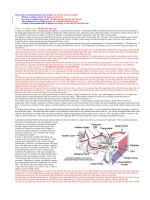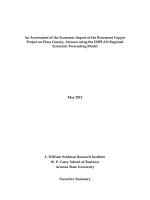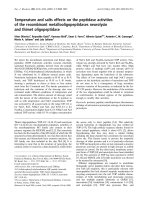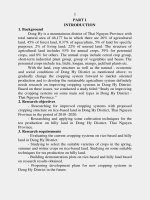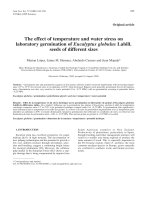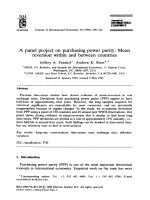Project on microprocessor the meter monitors the temperature and starts the cooling system
Bạn đang xem bản rút gọn của tài liệu. Xem và tải ngay bản đầy đủ của tài liệu tại đây (1.19 MB, 38 trang )
<span class="text_page_counter">Trang 1</span><div class="page_container" data-page="1">
HO CHI MINH CITY UNIVERSITY OF TECHNOLOGY AND EDUCATION FACULTY FOR HIGH QUALITY TRAINING
Project on Microprocessor
The meter monitors the temperature and starts the cooling system
Advisor : Lưu Hùng Group members:
Nguyễn Viết Cường 20151257 Nguyễn Hà Gia Huy 20151283 Phan Anh Phú 20151329
</div><span class="text_page_counter">Trang 2</span><div class="page_container" data-page="2">HO CHI MINH CITY UNIVERSITY OF TECHNOLOGY AND EDUCATION FACULTY FOR HIGH QUALITY TRAINING
Project on Microprocessor
Graduation project review sheet (For instructor)
Group members:
Nguyễn Viết Cường 20151257 Nguyễn Hà Gia Huy 20151283
Phan Anh Phú 20151329
Topic: The meter monitors the temperature and starts the cooling system Major: Electrical and Electronics Engineering Technology
</div><span class="text_page_counter">Trang 4</span><div class="page_container" data-page="4">To complete the university program and successfully carry out this project, my team would like to thank the teachers of the Faculty of electrical and electronics of the University of Technology and Education of Ho Chi Minh City during this time. The teachers gave me a lot of knowledge so that my group could complete the topic "The meter monitors the temperature and starts the cooling system”.
Especially, we would like to thank to Luu Hung for his enthusiastic guidance and suggestions to come up with ideas when the group had difficulty in developing ideas.
Sincere thanks!
<small>3</small>
</div><span class="text_page_counter">Trang 5</span><div class="page_container" data-page="5">We hereby state that the topic: “The meter monitors the temperature and starts the cooling system” is a research working under the guidance of Luu Hung. Besides, we do not have any copying from the other works. We will take full responsibility if there are any problems occur.
</div><span class="text_page_counter">Trang 6</span><div class="page_container" data-page="6">The concept of temperature measurement has been around for a long time, among all physical quantities, temperature is the most concerned, temperature is the factor that directly affects the properties and materials of the living environment. Nowadays when industry and agriculture thrive, temperature control is very important.
To clarify the practical application and effectiveness of the electrical-electronic industry, after a period of study and research on the topic "The meter monitors the temperature and starts the cooling system”. This system can help us to monitor the temperature in the most optimal way by using electronic components.
Table of Content
<small>5</small>
</div><span class="text_page_counter">Trang 7</span><div class="page_container" data-page="7">Chapter 1: Introduction...11
1.1 The practical problems...11
1.2 The aim of the topic...11
1.3 Object and scope of the study...11
1.4 The advantage of meter monitors the temperature and starts the cooling system...12
1.5 Research content...12
Chapter 2: Theoretical foundations of system operation...13
2.1.1 Working principle of the system...13
Chapter 3: Perform monitoring, operate the temperature monitoring meter and start the cooling system...25
3.1 Problem solving...25
3.1.1 Block diagram of the system...25
3.1.2 Detailed design...26
3.2 The principle of operation of the circuit...29
3.3 Construction and results...30
</div><span class="text_page_counter">Trang 8</span><div class="page_container" data-page="8">3.3.1 Software...30
3.3.2 Communication control software (CCS C Compiler)...30
3.3.3 Draw the principle diagram; run simulation on software...31
</div><span class="text_page_counter">Trang 9</span><div class="page_container" data-page="9">Table of Figure
Figure 2.1 PIC16F887...14
Figure 2.2 Pinout of PIC16F877...15
Figure 2.3 Temperature sensor...18
Figure 3.1 Detailed diagram of system...26
Figure 3.2 Source block...26
Figure 3.3 Display block...27
Figure 3.4 Relay block...28
Figure 3.5 Processing block...29
Figure 3.6 Software interface Proteus 8.12...30
Figure 3.7 Software interface of CCS C Compiler...30
Figure 3.8 Circuit layout...32
Figure 3.9 3D simulation circuit front panel...33
Figure 3.10 3D simulation circuit rear panel...33
Figure 3.11 Circuit after construction - front view...34
</div><span class="text_page_counter">Trang 11</span><div class="page_container" data-page="11">CHAPTER 1: INTRODUCTION
1.1 The practical problemsThe concept of temperature measurement has been around for a long time, of all the physical quantities, temperature is the most interested. Temperature is a factor that directly affects the properties of matter and the environment. In the abalone mushroom industry and the field of measurement and control, temperature measurement and result processing play an important role.
Today, industry and agriculture thrive, temperature monitoring plays a very important role in engineering because the device makes monitoring temperature, humidity, time easily and conveniently. Industry standard equipment with high stability and accuracy.
Therefore, in the microprocessor of the Faculty of High-Quality Training- Ho Chi Minh University of Technology and Education and the guidance of Mr. Nguyen Thanh Nghia, our group learned about: The meter monitors the temperature and starts the cooling system
1.2 The aim of the topic
Monitor temperature and start the cooling system correctly Specific goals are as follows:
Overview description of temperature monitoring meter and cooling system startup
Detailed explanation of each electronic component
Build a temperature monitoring system and start it up by programming Construction, control and supervision of the system
test and evaluate the results
1.3 Object and scope of the study
The object of research is a temperature monitoring clock system built by electronic components such as: PIC16F887, CAPACITOR, led segment, IC LM7805, temperature sensor (LM35), RESISTOR,…
</div><span class="text_page_counter">Trang 12</span><div class="page_container" data-page="12">1.4 The advantage of meter monitors the temperature and starts the cooling system
A temperature meter is an electronic device with a display used to measure temperature and humidity in many different environments. This is also a necessary and important device in today's life.
Used to monitor the temperature in rooms, workplaces, companies or
Chapter 2: Theoretical foundations of system operation
Chapter 3: Perform monitoring, operate the temperature monitoring meter and start the cooling system
Chapter 4: Conclusion
<small>11</small>
</div><span class="text_page_counter">Trang 13</span><div class="page_container" data-page="13">CHAPTER 2: THEORETICAL
FOUNDATIONS OF SYSTEM OPERATION
The meter monitors the temperature and starts the cooling system using an infrared thermal sensor to measure the temperature. The sensor is connected to a pre-programmed circuit board. As the measurement takes place, the sensor collects information, transmits it to the control panel and then displays the measurement results on the screen.2.1 The components of system
Basically a temperature meter is divided into 2 parts, the temperature sensor part and the temperature display part. With the needle display type, there will be a mechanism called an actuator, with the digital display type, there will be a part called a signal processor.
2.1.1 Working principle of the system
With a conventional needle display type, the temperature sensor part is a bimetallic piece (2 pieces of temperature-sensitive metal joined together). When the bimetallic piece is exposed to heat, it will cause non-uniform expansion between the two pieces of metal, leading to the warping of the bimetallic piece. Depending on the high and low temperature, this bimetallic piece will bend more or less, when the degree through the transmission mechanism rotates the clockwise, the manufacturer's calculation will indicate the exact temperature.
With the digital display type, the returned thermal signal is a voltage (thermocouple, also known as a thermocouple), the input voltage changes based on the changing temperature. Or according to the change of resistance (can PT, aka RTD), the resistance changes with temperature. The signal is returned to the signal processor and then displays the exact temperature of the area to be measured
2.1.2 Category
Needle display type and digital display type.
</div><span class="text_page_counter">Trang 14</span><div class="page_container" data-page="14">2.1.3 Specifications
- Measuring range
- Mounting type, mounting dimensions (diameter, length, thread type)
2.1.4 Note
- If high accuracy is required, stable operation should choose digital display type - Application: commonly used in steel, engineering, technology, beverage,
textile, food, chemical...
2.2 Introduction to electronic components 2.2.1 PIC16F887
a. Introduction
PIC16F887 is a microcontroller chip manufactured by Microchip in the Pic family. PIC16F887 is an 8-bit microcontroller based on RISC architecture 8KB ISP flash program memory that can be written and erased thousands of times, 256B EEPROM, a huge amount of RAM in the world of 8-bit processors (368B SRAM).
With 33 pins usable for I/O connections, 32 registers, 3 programmable timers/counters, internal and external interrupts (2 instructions per interrupt vector), transmission protocol USART, SPI, I2C serial communication. In addition, a 10-bit analog-digital converter (ADC/DAC) can be used up to 11 channels, programmable watchdog timer, operation with 5 power modes, up to 2 modulation channels can be used. pulse width (PWM)……
Figure 2.1 PIC16F887
b. Specifications of PIC16F887
<small>13</small>
</div><span class="text_page_counter">Trang 15</span><div class="page_container" data-page="15">Datasheets PIC16F882/883/884/886/887
PWM, WDT
Voltage – Supply (Vcc/Vdd) 4.2 V ~ 5.5 V
Table 2.1 Specifications of PIC16F887 c. Pinout of PIC16F877
Figure 2.2 Pinout of PIC16F877 d. Responsibilities of each component
</div><span class="text_page_counter">Trang 16</span><div class="page_container" data-page="16">numerical order name Describe
<small>15</small>
</div><span class="text_page_counter">Trang 17</span><div class="page_container" data-page="17">1 MCLR / Vpp MCLR is used during programming, mainly connected to a programmer like PicKit
</div><span class="text_page_counter">Trang 18</span><div class="page_container" data-page="18">The LM35 is a widely used temperature sensor. It shows the values as output voltage instead of degrees Celsius.
A temperature sensor is a thermocouple – an electrical device consisting of two dissimilar electrical conductors that form electrical junctions at different temperatures, or a resistance temperature detector (RTD) that measures heat from a source concrete and transform the information gathered into a structured form
Temperature sensors are commonly used in HV systems and AC environmental control systems, medical equipment, food handling sensors, chemical processing, automotive control systems, etc.
<small>17</small>
</div><span class="text_page_counter">Trang 19</span><div class="page_container" data-page="19">Figure 2.3 Temperature sensor
b. Features of temperature sensor IC LM35
- The minimum and maximum input voltages are 35V and -2V respectively. Typical is 5V.
- Can measure temperatures from -55°C to 150°C.
- The output voltage is (linearly) proportional to temperature i.e. there will be a 10mV (0.01V) increase for every 1°C rise in temperature.
- Accuracy ± 0.5°C - It is cheap
- Small and therefore suitable for remote applications
c. Pinout of LM35
increase. Can range from -1V (-55°C)
</div><span class="text_page_counter">Trang 20</span><div class="page_container" data-page="20">TO-92, Dpark, TO-03. IC 7805 is widely used in commercial and educational equipment as a good device to power the TTL family of digital integrated circuits. It is also used by many electronics enthusiasts and mechanics due to its low cost, ease of use and lack of external components. The IC has many built-in features that are ideal for use in many electronic applications such as 1.5A output current, overload protection, over temperature protection, low static current, etc.
Figure 2.4 IC LM7805
b. Features of IC LM7805 - Output current is 1.5A
- Instant short circuit shutdown function - Instant overheat shutdown function - Cheap
- Reliable for use in commercial devices - Precise and fixed 5V output
- Minimum input voltage to provide 5V output: 7.3V. below 7.3V chip may not provide stable 5 volts.
- Maximum input voltage 35V DC - Low static current only 8mA c. Pinout of LM7805
Table 2.4 Pinout of LM7805
<small>19</small>
</div><span class="text_page_counter">Trang 21</span><div class="page_container" data-page="21">2.2.4 Seven segment led a. Introduction
The main advantage of light emitting diodes is that because of their small die size, several of them can be connected together within one small and compact package producing what is generally called a 7-segment Display.
Each of the seven LEDs is called a segment because when illuminated the segment forms part of a numerical digit (both Decimal and Hex) to be displayed. Each one of the seven LEDs in the display is given a positional segment with one of its connection pins being brought straight out of the rectangular plastic package. These individually LED pins are labelled from a through to g representing each individual LED. The other LED pins are connected together and wired to form a common pin.
This display has nothing more than 8 LED inside it. These 8 LEDs are separated into each segments which can be named as a, b, c, d, e, f, g, DP as shown in the picture above.
Figure 2.5 7-Segnment Led b. Seven segment led structure
</div><span class="text_page_counter">Trang 22</span><div class="page_container" data-page="22">Table 2.5 Seven segment led structure 2.2.5 Relay
A relay is an electromagnetic switch operated by a relatively small current that can turn a much larger current on or off. The heart of the relay is an electromagnet (a coil of wire that becomes a temporary magnet when current flows through it).
The relay has two states on and off whether the current flows through the relay suction coil or not.
b. Structure of relay
The relay terminals are usually denoted COM, NC and NO:
- COM (common): is a common pin, it is always connected to 1 of the other 2 pins. As for which pin it is connected to, it depends on the operating state of the relay. - NC (Normally Closed): Normally Closed. When the relay is in the OFF state, the COM pin will be connected to this pin.
- NO (Normally Open): Normally Open. When the relay is in the ON state (with current flowing through the coil), the COM pin will be connected to this pin.
Figure 2.6 Relay
c. Features of relay Optimum excitation voltage:
- This parameter is quite important because it will determine whether your relay can be used or not. For example, you need a relay module that will turn on and off a light bulb with a voltage of 220V when it is dark from a light sensor operating at 5 -12V. Maximum voltage and amperage:
- These are the parameters showing the maximum current as well as voltage of the devices that you want to switch on/off that can be wired to the relay.
<small>21</small>
</div><span class="text_page_counter">Trang 23</span><div class="page_container" data-page="23">- 10A – 250VAC: the maximum amperage through the relay contacts is 10A with a
Transistor A1015 is a PNP type bipolar transistor electronic device. The A1015 is manufactured in a TO-92 plastic case.
The A1015 is a good quality low cost PNP transistor, designed primarily for use as an audio amplifier or in audio amplifier stages. The collector-to-emitter voltage of the transistor is 50V so it can easily be used in circuits operating below 50V. For good performance, this transistor should be used in circuits operating below 40V DC. The maximum power dissipation of the transistor is 400mW and the maximum DC current amplification is 400, so this transistor is suitable for amplifying small sounds. Furthermore it can also be used as a switch and it can handle 150mA load.
</div><span class="text_page_counter">Trang 24</span><div class="page_container" data-page="24">2.2.7 Transistor NPN C1815 a.Introduction
It is designed to amplify audio frequencies and high frequency OSCs. The transistor's collector base voltage is 50V so it can easily be used in circuits that use less than 50V DC. The collector current of the transistor is 150mA so it can drive any load below the 150mA limit. The power dissipation of the collector and the DC current gain of the transistor are quite good as it is ideal for use in audio amplification and electronic signal amplification. In addition, it can also be used as a switch to control loads below 150mA
Transistor C1815 can be used in audio amplification stages, small sound amplification (if used to drive small loudspeakers), preamplifier and also in preamplifier stages. It can also be used as a switch in electronic circuits to control loads below 150mA, for example to control relays, other high power transistors, low power LEDs and other parts of electronic circuits, … It can also be used to create darlington pairs.
b. Feature of C1815 - Transistor Type: NPN
- Maximum current IC kit (I ): 150mA<small>c</small> - Collector-Emitter peak voltage (V ): 50V<small>ce</small> - Collector-Base peak voltage (V ): 60V<small>cb</small> - Peak emitter voltage (V<small>EBO</small>): 5V
- Max Collector Dissemination (Pc): 400 mW - Maximum switching frequency (f ): 80 MHz<small>t</small>
- Minimum and maximum DC current gain (h ): 70 – 700<small>fe</small>
- Maximum storage and operating temperature should be: -55 to +150 C<small>0</small>
Figure 2.8 Pinout of C1815
<small>23</small>
</div>
